THE BACKCOURT
The backcourt players or diggers, as they are sometimes called, arrange themselves
according to three different patterns: perimeter, rotate, and counter rotate.
The frontcourt blockers influence the positions of the backcourt players. Depending
upon the number of players actually blocking, one or two and sometimes three,
and the position of these blockers at the net, the backcourt players will make
final adjustments.
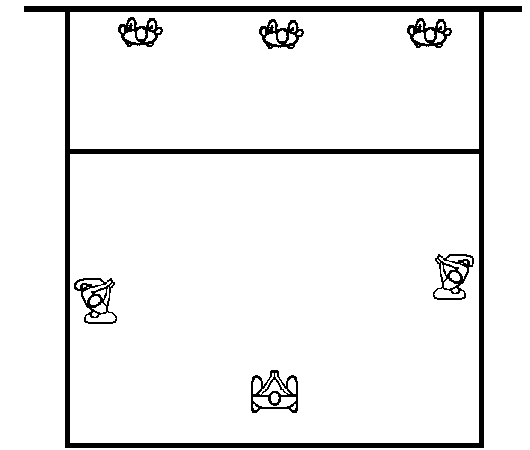
A team, either after its serve or its attack, will arrange the players in a
defensive alignment close to the perimeter of the court. This starting arrangement
allows each player to move quickly to her final defensive position (figure 1.)
The Perimeter System
A majority of attacks arrive near the borders of the court. The most common
backcourt design is the perimeter (figure 1.)
The strength of the perimeter is in covering the hard spike with four diggers.
The weakness of this defense is that it is vulnerable to tips, especially those
tips to the center of the court.
The read positions in the perimeter defense for a rightside attack are:
- The middle back takes a position on the endline in line with the hitter's
approach. She covers the attack that goes through or over the block.
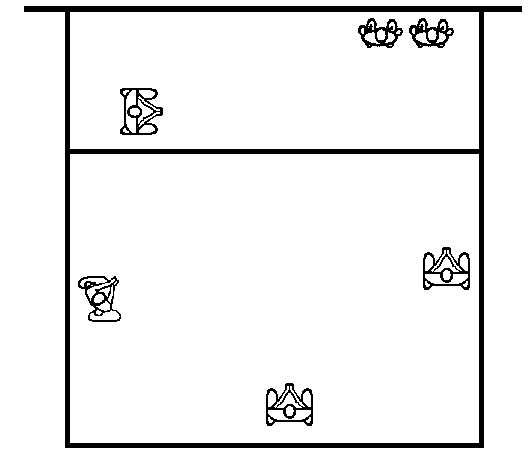
- The rightback and leftback diggers take a position on the sidelines outside
the blocker or blockers' shoulders and face the attack. They read the hitter's
intentions (attack or tip) and react accordingly. If the hitter attacks the
set, then the rightback and leftback take a position to dig the ball. If the
hitter tips the ball, then they run forward and pass the ball keeping in mind
the rule of parallels.
- The fourth digger, the leftside blocker, positions herself near or on the
attack line behind her starting point at the net. She reads the hitter's intentions
(attack or tip.) If the hitter attacks, the leftside blocker positions herself
to dig a sharp angle spike. If the attacker tips toward the middle of the court,
the leftside blocker runs forward and passes the ball keeping in mind the rule
of parallels.
- As the hitter's point of attack moves closer to the center of the net, the
rightback digger moves forward.
The read positions in the perimeter defense for a leftside attack are:
- The middle back takes a position on the endline in line with the hitter's approach.
She covers the attack that goes through or over the block.
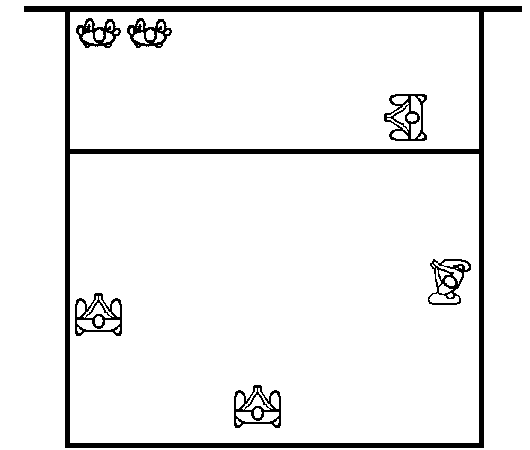
- The rightback and leftback diggers take a position on the sidelines outside
the blocker or blockers' shoulders and face the attack. They read the hitter's
intentions (attack or tip) and react accordingly. If the hitter attacks the
set, then the rightback and leftback take a position to dig the ball. If the
hitter tips the ball, then they run forward and pass the ball keeping in mind
the rule of parallels.
- The fourth digger, the rightside blocker, positions herself near or on the
attack line behind her starting point at the net. She reads the hitter's intentions
(attack or tip.) If the hitter attacks, the rightside blocker positions herself
to dig a sharp angle spike. If the attacker tips toward the middle of the court,
the rightside blocker runs forward and passes the ball keeping in mind the rule
of parallels.
- As the hitter's point of attack moves closer to the center of the net, the
leftback digger moves forward.
The positions in the perimeter defense for a middle attack depend upon whether
an outside blocker helps the middle blocker. Generally, if a double block is
to be used, the leftside blocker will combine with the middle blocker to prevent
the middle attack.
The read positions in the perimeter defense for a middle attack, leftside blocker
and middle blocker combined are:
- The middleback must read the position and height of the set before she adjusts
her defensive position. If she determines that a quick attack will occur she
maintains her position and prepares to dig any spikes directed toward her. If
the set is high, she can take a position on the endline in line with the hitter's
approach. She covers the attack that goes through or over the block.
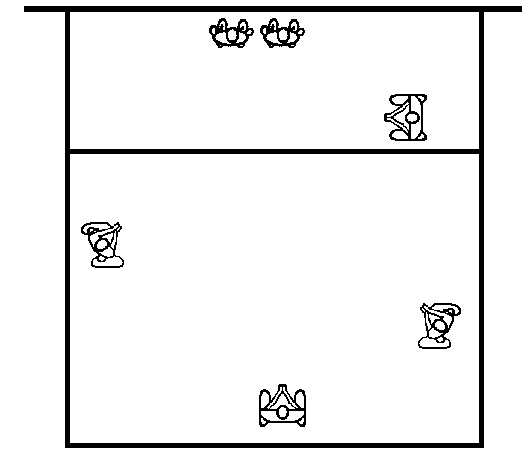
- The rightback and leftback diggers take a position on the sidelines outside
the blockers' shoulders and face the attack. The rightback is normally deeper
toward the endline. They read the hitter's intentions (attack or tip) and react
accordingly. If the hitter attacks the set, then the rightback and leftback
take a position to dig the ball. If the hitter tips the ball, then they run
forward and pass the ball keeping in mind the rule of parallels.
- The fourth digger, the rightside blocker, positions herself near or on the
attack line behind her starting point at the net. She reads the hitter's intentions
(attack or tip.) If the hitter attacks, the rightside blocker positions herself
to dig a sharp angle spike. If the attacker tips toward the middle of the court,
the rightside blocker runs forward and passes the ball keeping in mind the rule
of parallels.
The read positions in the perimeter defense for a middle attack, rightside
blocker and middle blocker combined are:
- The middleback must read the position and height of the set before she adjusts
her defensive position. If she determines that a quick attack will occur she
maintains her position and prepares to dig any spikes directed toward her. If
the set is high, she can take a position on the endline in line with the hitter's
approach. She covers the attack that goes through or over the block.
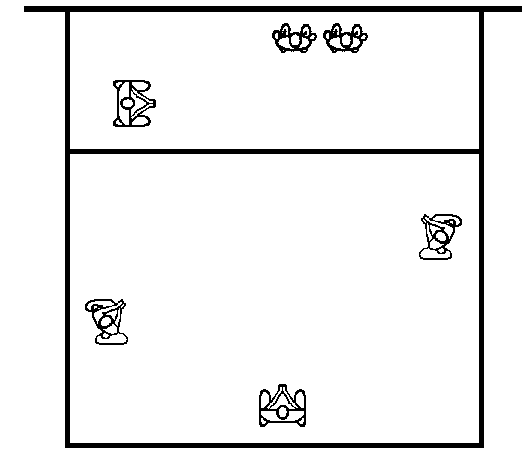
- The rightback and leftback diggers take a position on the sidelines outside
the blocker or blockers' shoulders and face the attack. They read the hitter's
intentions (attack or tip) and react accordingly. If the hitter attacks the
set, then the rightback and leftback take a position to dig the ball. If the
hitter tips the ball, then they run forward and pass the ball keeping in mind
the rule of parallels.
- The fourth digger, the leftside blocker, positions herself near or on the
attack line behind her starting point at the net. She reads the hitter's intentions
(attack or tip.) If the hitter attacks, the leftside blocker positions herself
to dig a sharp angle spike. If the attacker tips toward the middle of the court,
the leftside blocker runs forward and passes the ball keeping in mind the rule
of parallels.
The Rotate System
Diggers rotate toward the attack
The rotate backcourt system, a variation of the perimeter, rotates the defenders
toward the point of attack. Its final arrangement includes two diggers on the
line. One digger is directly behind the block and one digger near the baseline.
The strength of the rotate system is in covering the line and the tip. The
weakness is in having one less digger in the backcourt.
The starting positions for the rotate defense are the same as in the perimeter
defense.
For the rightside attack: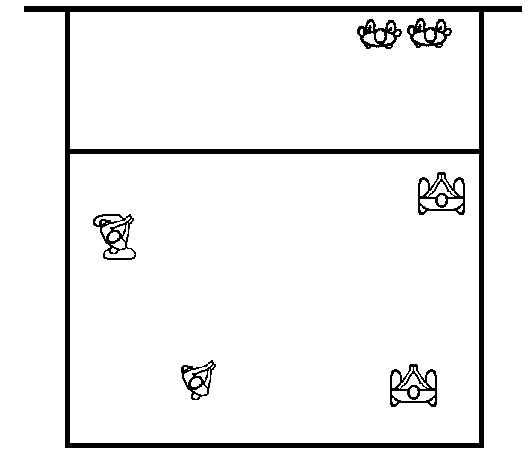
- The rightback rotates from her starting position and takes a position on
the attack line behind the double block. She guards against the tip.
- The middleback rotates to the right corner, behind the right back. She faces
the attack.
- The leftback rotates to the left corner covering the deep angle.
- 4. The leftfront blocker moves away from the net and takes a position behind
the attack line.
For the leftside attack: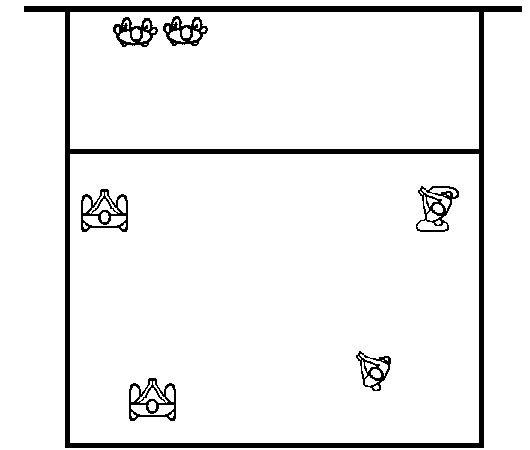
- The leftback rotates from her starting position and takes a position on
the attack line behind the double block. She guards against the tip.
- The middleback rotates to the left corner, behind the leftback. She faces
the attack.
- The rightback rotates to the right corner covering the deep angle.
- The rightfront blocker moves away from the net and takes a position behind
the attack line.
The Counter Rotate System
Diggers rotate away from the Attacker.
The counter rotate is another version of the perimeter defense system. The
backcourt in this design rotates away from the attack.
The final arrangement of the players includes one defender behind the blockers
to cover the tips. This defender, usually the off-blocker, positions herself
near the center of the attack line. This places two diggers on the angle and
one defender on the line.
The strength of the counter rotate system is in covering the tip and for attackers
who hit primarily cross court.
The starting positions for the counter rotate are the same as for the perimeter.
For the rightside attack: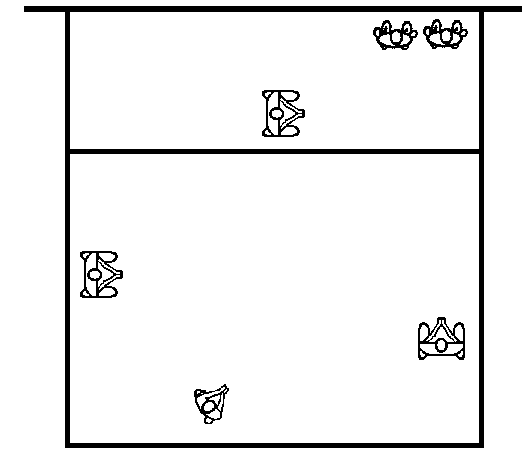
- The rightback stays on the sideline facing the attacker. She moves backward
while facing the attacker and takes a position six feet from the endline.
- The middleback moves to the left corner and covers the deep angle.
- The leftback moves forward near the attack line and digs the sharp angle.
- The leftfront blocker moves away from the net and takes a position near
the center of the attack line. She covers the tip behind the blockers.
For the leftside attack: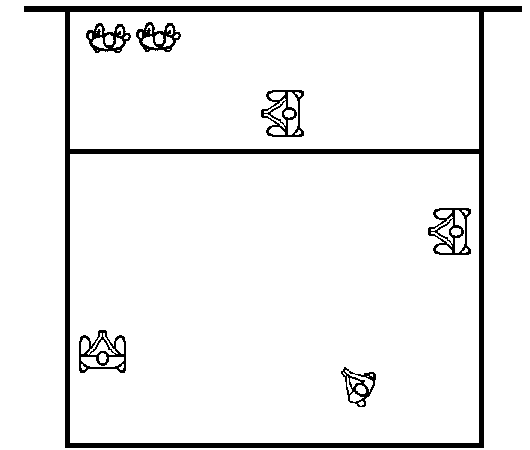
- The leftback stays on the sideline facing the attacker. She moves backward
while facing the attacker and takes a position six feet from the endline.
- The middleback moves to the right corner and covers the deep angle.
- The rightback moves forward near the attack line and digs the sharp angle.
- The rightfront blocker moves away from the net and takes a position near
the center of the attack line. She covers the tip behind the blockers.
For the middle attack the leftfront blocks with the middle. 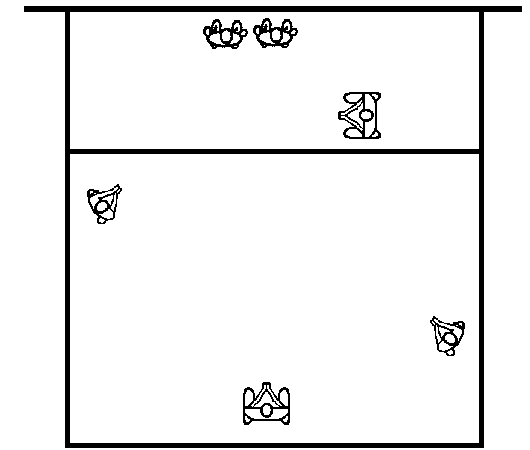
- The rightfront blocker moves away from the net and takes a position near the
attack line and to the right of the nearest blocker.
- 2. The rightback, staying near the sideline, rotates to a position halfway
between the attack line and endline. She lines herself up on the middle blocker's
right shoulder and digs all balls outside the block.
- The middleback lines up on the endline behind the block.
- The leftback, staying near the sideline, rotates to a position near the
attack line. She lines herself up on the left blocker's left shoulder and digs
all balls outside the block near the attack line.










